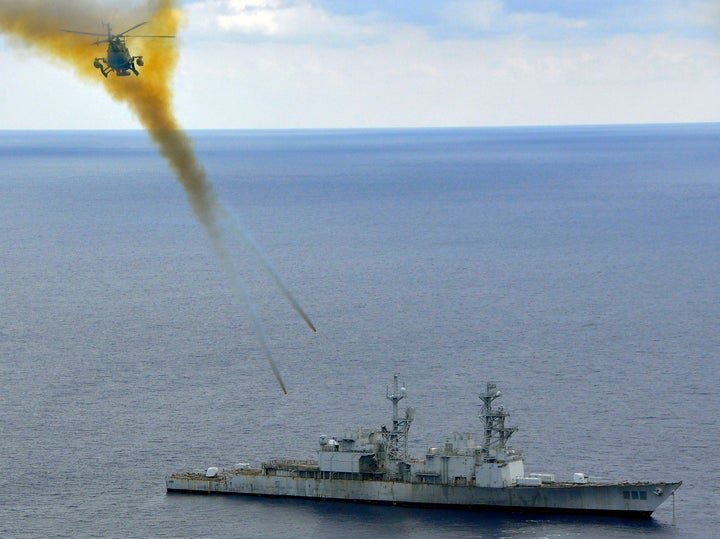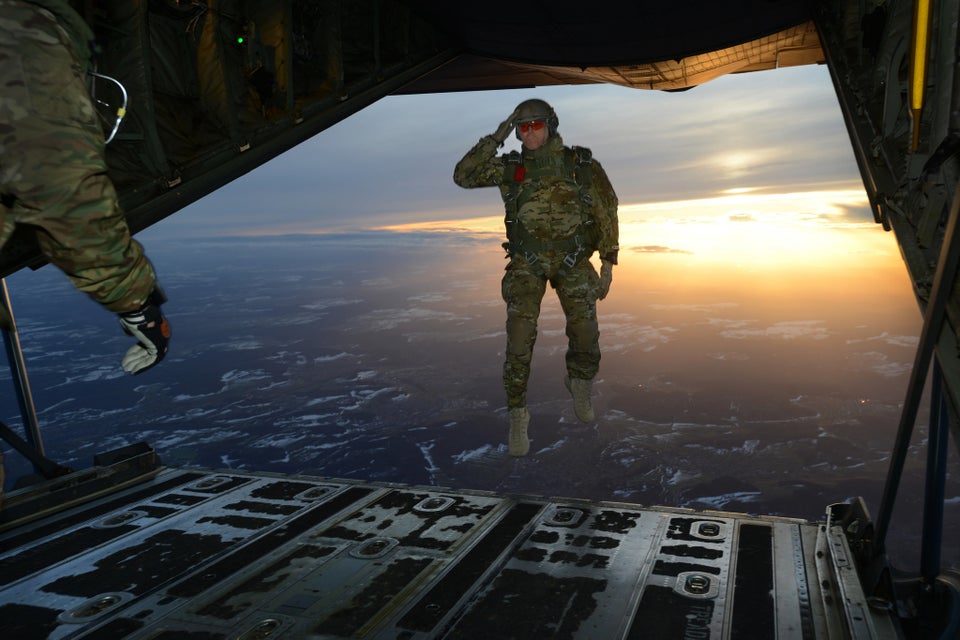Fifty miles north of the Hawaiian island of Kauai, more than a mile below the ocean surface, lies a dark, watery graveyard of ships.
Since 1999, 52 vessels have reached their final resting place here as part of SINKEX, the Navy’s ship sinking program.
SINKEX uses retired ships for live-fire target practice, which involves towing them out to sea and shooting at them with missiles and torpedoes until they plunge beneath the surface.
"The U.S. Navy has a long history of using decommissioned vessels for weapons development testing and fleet combat training," Agnes T. Tauyan, a spokeswoman for Navy Region Hawaii, told The Huffington Post in an email. "The SINKEX program results in numerous benefits to the Navy by providing environmentally sound target vessels for at-sea live-fire exercises."
But SINKEX has plenty of critics, including those who say sinking old ships wastes recyclable steel and negatively affects the marine environment.
"It's an unfortunate leftover of a bygone era," Marti Townsend, director of Hawaii's chapter of the Sierra Club, told HuffPost. "The U.S. should just not be this wasteful anymore."
Conservation groups, including the Sierra Club and Basel Action Network, filed a lawsuit against the Environmental Protection Agency in 2011, alleging the agency has failed to prevent the SINKEX program from polluting the sea with toxic chemicals -- specifically, polychlorinated biphenyls, or PCBs, a group of chemicals that are dangerous to human health.
While the plaintiff groups were forced to drop the complaint in 2013 due to a lack of funding, their concerns remain the same. BAN's Colby Self told HuffPost that "Nothing has changed whatsoever ... They're still dumping tons of toxic materials."

PCBs have been banned globally because they're "some of the most dangerous pollutants around," according to a 2012 statement by Emily Jeffers of the Center for Biological Diversity, a group that joined the Sierra Club and BAN in petitioning the EPA to address the health and environmental risks associated with SINKEX.
"They leach from sunken ships into the ocean and accumulate in the bodies of fish, dolphins and whales," she wrote. "Our oceans should never be used as a dump for poison.”
According to the petition the environmental groups submitted to the EPA, SINKEX missions are becoming more common as the Navy looks to dispose of its inventory of inactive vessels in a cost-effective manner: from 1970 to 1999, SINKEX missions accounted for 8 percent of all Navy vessel disposals; from 2000 to 2010, they accounted for 65 percent.
The EPA ultimately denied the petitioners' requests, saying existing regulations sufficiently "address the risks to human health and the environment from PCBs."
The Navy puts each vessel through a "rigorous cleaning process" before sinking it, Tauyan told HuffPost. She said this includes removing all PCBs, trash, mercury- or fluorocarbon-containing materials, fuel and other potentially harmful substances.
Townsend, however, is not convinced. "There's no amount of cleaning that can guarantee it's all gone," she said.

The Navy imposed a moratorium on the SINKEX missions in 2010 to conduct a comprehensive review of the requirements, costs, benefits and environmental impact of the program. The missions resumed in 2012, however, when three inactive vessels were sunk off Kauai as part of the biennial Rim of the Pacific naval exercises. Two more ships met the same fate in 2014.
SINKEX missions take place in the general area around 23 degrees 53 minutes north latitude and 159 degrees 35 minutes west longitude, Tauyan said. To minimize potential harm, the Navy sinks the ships in water at least 6,000 feet deep and at least 50 nautical miles from land, and only after the area has been surveyed for the presence of marine mammals.
The Navy says SINKEX events provide a unique opportunity to conduct testing and training activities and refine live-fire tactics, techniques and procedures.
"SINKEX events enhance combat readiness by providing realistic training that cannot be duplicated in simulators," Tauyan wrote.

No sinking exercises are approved for the remainder of 2015, but Rim of the Pacific naval exercises -- which the U.S. Pacific Fleet hosts every two years -- will return to the waters around Hawaii in 2016. RIMPAC is the world’s largest international maritime war exercise: In 2014, 22 nations, 49 surface ships, six submarines, more than 200 aircraft and 25,000 personnel participated in the exercises.
"Historically, each RIMPAC has included sinking exercises, and that is an option that is being considered, but the details are not yet finalized for 2016," Tauyan told HuffPost.
The Navy conducts most of its sinking exercises at four major locations -- north of Kauai, off the coast of California, off the coast of the eastern U.S. and off the coast of Puerto Rico.
Watch the video below to see harpoon and naval strike missiles sink the decommissioned USS Ogden:
Also on HuffPost:

